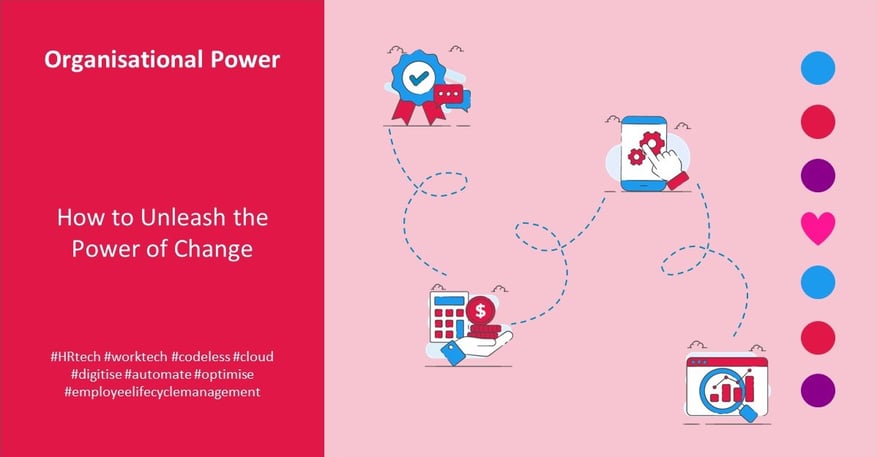The events of early 2020 forced companies worldwide to rapidly adapt to new challenges – a "new normal" of remote work, scaled-down teams, and limited physical interactions. As we approach three years in this transformed business environment, it’s a great opportunity to reflect on the state of our organisations’ workplace culture.
Here is a hard pill to swallow: most people on our planet are unhappy with their jobs. Employees everywhere are feeling unhappy, unfulfilled, unappreciated, and stifled, resulting in diminished performance.
It's time to create a thriving environment where employees bring their best selves to work every day. ✨
In this blog post, we will delve deeper into the significance of organisational culture. By the end of this article, you'll have a comprehensive understanding of the power of culture and the steps you can take to foster a thriving, dynamic, and purpose-driven workplace. 👍

Understanding Organisational Culture: Definition and Meaning
The concept of organisational culture is more than just a buzzword; it is the fabric that weaves together the values, beliefs, behaviours, and norms within a company. It encompasses the collective mindset and shared understanding of how things should be done. 🌍
At its core, organisational culture shapes the way employees interact with one another, approach their work, and engage with the company's mission and goals. It influences the overall atmosphere, communication patterns, decision-making processes, and even the level of employee satisfaction and engagement.
Though it is hard to define organisational culture, its importance cannot be overstated. It sets the tone for the entire workplace, influencing employee attitudes, behaviours, and performance. A positive and strong culture promotes a sense of belonging, purpose, and motivation, leading to higher levels of employee engagement, productivity, and retention.
On the other hand, a toxic or weak culture can breed negativity, conflict, and disengagement, ultimately undermining the organisation's success.
When leaders understand and actively shape organisational culture, they can create an environment that fosters collaboration, innovation, and adaptability. It becomes the foundation upon which the company's values, mission, and vision are built, guiding decision-making processes and shaping the overall employee experience.
Moreover, organisational culture plays a crucial role in attracting and retaining top talent. In today's competitive job market, prospective employees seek out companies that align with their values and provide a supportive and inclusive work environment. A strong culture serves as a magnet, attracting like-minded individuals who are passionate about the company's mission and eager to contribute their best. 🙌
The Different Types of Organisational Culture
The face of organisational culture will vary significantly from one organisation to another, as it is influenced by various factors such as industry, leadership style, and the company's history and values.
➡️ Let's explore some common organisational culture examples to provide you with a better understanding of the variations and their implications for workplace dynamics.
Hierarchical Culture
In a hierarchical culture, there is a strong emphasis on authority, control, and clear lines of authority. Decision-making tends to be top-down, with a clear chain of command. Roles and responsibilities are well-defined, and employees follow established procedures and protocols. This type of culture is often found in traditional and bureaucratic organisations.
🎖️ Hierarchal Organisational Culture Example: Government agencies, large corporations with a strict hierarchy, and military organisations.
Innovative Culture
An innovative culture values creativity, experimentation, and risk-taking. Employees are encouraged to think outside the box, challenge the status quo, and contribute new ideas and solutions. This culture fosters a sense of autonomy and supports continuous learning and improvement.
🧪 Innovative Organisational Culture Example: Technology companies like Google and Apple, startups, and design firms.
Collaborative Culture
Collaborative cultures promote teamwork, cooperation, and open communication. Employees work together across departments, share knowledge and resources, and strive for collective success. This culture encourages a sense of unity and fosters a supportive and inclusive environment.
👫 Collaborative Organisational Culture Example: Non-profit organisations, creative agencies, research institutions.
Customer-Oriented Culture
In a customer-oriented culture, the focus is on delivering exceptional customer experiences. Employees prioritise customer needs, go the extra mile to exceed expectations, and aim to build long-term relationships. This culture emphasises responsiveness, empathy, and a deep understanding of customer preferences.
👱 Customer-Oriented Organisational Culture Example: Hospitality industry, service-based businesses, customer support centres.
Results-Driven Culture
A results-driven culture values outcomes, performance, and achieving measurable goals. There is a strong emphasis on accountability, efficiency, and continuous improvement. Employees are motivated by clear objectives and are rewarded based on their achievements.
💸 Results-Driven Organisational Culture Example: Sales organisations, high-performance sports teams, and financial institutions.
It's important to note that these culture types are not mutually exclusive, and many organisations exhibit a blend of different cultural elements. Additionally, the type of culture that works best for a company depends on its specific goals, industry, and values.
The Factors that Influence Organisational Culture
Organisational culture is shaped by various factors that collectively contribute to the shared values, beliefs, and behaviours within a company.
Understanding these factors is essential for leaders and HR professionals who aim to shape and maintain a positive and effective organisational culture. Let's explore some key factors that influence organisational culture.👇
Leadership Style
Leadership plays a crucial role in shaping organisational culture. The actions, decisions, and behaviours of leaders influence how employees perceive and experience the workplace. Leaders who embody and promote the desired values and behaviours set the tone for the entire organisation.
Organisational Values
Organisational values reflect the guiding principles and beliefs that define what the company stands for. They serve as a compass for decision-making and behaviour within the organisation. When shared values are aligned with employee actions, it fosters a strong and cohesive culture.
Workplace Environment
The physical and social environment of the workplace significantly impacts culture. Factors such as office layout, amenities, and the overall atmosphere influence employee engagement, collaboration, and well-being. A positive and inclusive environment can foster a culture of trust, innovation, and productivity.
Employee Engagement
Employee engagement refers to the level of commitment and involvement employees have towards their work and the organisation. Engaged employees are more likely to embrace and contribute to the organisational culture. Factors such as opportunities for growth, meaningful work, and a supportive work environment enhance employee engagement.
Communication and Feedback
Effective communication and feedback channels are vital for shaping organisational culture. Transparent and open communication promotes trust, collaboration, and a sense of belonging. Regular feedback mechanisms, both formal and informal, help align employee actions with the desired cultural values.
Hiring and Onboarding Practices
The process of attracting, selecting, and onboarding new employees greatly influences organisational culture. Hiring individuals who align with the company's values and culture ensures cultural fit and strengthens the desired cultural traits within the organisation.
Organisational Structure
The structure and hierarchy of an organisation influence how decisions are made, information flows, and power dynamics within the company. A flexible and adaptive structure can foster innovation, collaboration, and a sense of empowerment, while a rigid and hierarchical structure may hinder creativity and autonomy.
Employee Diversity and Inclusion
Diversity and inclusion initiatives shape organisational culture by embracing and valuing differences among employees. Cultivating a diverse and inclusive culture enhances creativity, fosters empathy, and promotes a broader range of perspectives and ideas.
Recognition and Rewards
Recognition and reward systems play a vital role in reinforcing desired behaviours and values. When employees are recognised and rewarded for demonstrating cultural traits, it strengthens the organisational culture and motivates others to embody those values.
Organisational History and Traditions
The history and traditions of an organisation influence its culture. The values and practices established over time create a sense of identity and heritage within the company. Preserving and honouring meaningful traditions can contribute to a strong and cohesive organisational culture.
The Power of Organisational Culture
The Impact of Culture on Organisational Success
Organisational culture has a profound impact on the success and performance of a company. It influences how employees think, behave, and interact with one another, as well as with customers and stakeholders. Let's explore some key areas where organisational culture has a significant impact ⬇️
Performance and Productivity
A strong organisational culture promotes high performance and productivity. When employees align with the company's values and have a clear understanding of their roles and expectations, they are motivated to work towards common goals. A positive culture fosters a sense of accountability, dedication, and commitment, leading to improved individual and team performance.
Employee Engagement and Retention
Organisational culture plays a crucial role in employee engagement and retention. When employees feel a sense of purpose, connection, and fulfilment within the workplace, they are more likely to be engaged and committed to their work. A positive culture that values employee well-being, growth opportunities, and work-life balance promotes higher employee satisfaction, leading to improved retention rates.
Collaboration and Teamwork
A collaborative culture encourages teamwork, cooperation, and open communication among employees. When employees feel comfortable sharing ideas, seeking input from others, and working together towards common objectives, it fosters a sense of unity and synergy. Collaboration enhances problem-solving, innovation, and the ability to deliver high-quality outcomes as a team.
Adaptability and Change Management
In today's fast-paced business environment, adaptability is essential for success. A strong organisational culture promotes a growth mindset, agility, and willingness to embrace change. When employees are encouraged to take risks, learn from failures, and adapt to new circumstances, it enables the organisation to navigate challenges and seize opportunities effectively.
Customer Satisfaction and Loyalty
Organisational culture directly impacts customer satisfaction and loyalty. A customer-centric culture that values excellent service, responsiveness, and quality generates positive customer experiences. Employees who embody the organisational culture are more likely to deliver exceptional customer service, resulting in increased customer satisfaction and loyalty.
Innovation and Creativity
A culture that nurtures innovation and creativity drives competitive advantage. When employees are encouraged to think outside the box, experiment with new ideas, and share diverse perspectives, it fosters a culture of innovation. Such a culture promotes continuous improvement, fosters a spirit of creativity, and allows the organisation to stay ahead in a rapidly evolving market.
Reputation and Employer Branding
Organisational culture influences the reputation and employer branding of a company. A positive culture that values integrity, respect, and ethical practices enhances the company's reputation in the marketplace. It attracts top talent, as prospective employees seek organisations that align with their values and offer a positive work environment.
Employee Morale and Well-being
A healthy organisational culture positively impacts employee morale and well-being. When employees feel supported, valued, and connected to the company's mission and values, it enhances their overall job satisfaction and well-being. A positive culture that promotes work-life balance, employee development, and a supportive work environment contributes to higher employee morale.

Why Culture is a 2023 Requirement
Culture is more important than ever before, due to several factors that have shaped the business landscape in recent years. These factors have highlighted the critical role of culture in driving organisational success and have made it a top priority for companies. Here's why organisations can’t ignore culture in 2023 👇
Competitive Advantage
In a highly competitive market, a strong organisational culture becomes a key differentiator. It sets a company apart from its competitors by creating a unique identity, values, and employee experience. A positive culture that aligns with the company's strategic goals and resonates with customers can give a competitive edge, attracting both customers and top talent.
Employee Retention and Recruitment
Culture plays a pivotal role in attracting and retaining talented employees. In a job market where skilled professionals have numerous options, a positive culture becomes a magnet for top talent. Employees seek organisations that offer a supportive work environment, growth opportunities, and a strong sense of purpose. A compelling culture enhances employee satisfaction, leading to higher retention rates and a competitive advantage in recruitment.
Employee Engagement and Productivity
A thriving culture drives higher levels of employee engagement and productivity. When employees feel connected to the company's mission, values, and goals, they are more likely to go the extra mile and contribute their best efforts. A positive culture fosters a sense of ownership, pride, and commitment, resulting in increased productivity, innovation, and overall business performance.
Adaptability to Change
The ability to adapt to change is crucial for survival in a rapidly evolving business landscape. A strong culture built on trust, transparency, and open communication creates an agile and adaptable workforce. Employees who embrace change, learn from failures, and continuously seek improvement contribute to an organisation's resilience and ability to seize new opportunities.
Customer Satisfaction and Loyalty
Culture directly impacts customer satisfaction and loyalty. A customer-centric culture that values exceptional service, responsiveness, and ethical practices fosters positive customer experiences. Employees who embody the culture become brand ambassadors, delivering exceptional service and building strong customer relationships, leading to increased customer satisfaction and loyalty.
Innovation and Creativity
Culture plays a vital role in fostering a culture of innovation and creativity. A supportive and inclusive culture encourages employees to think differently, challenge the status quo, and generate fresh ideas. When employees feel empowered to take risks, share their perspectives, and collaborate, it fuels innovation and drives competitive advantage in the market.
Brand Reputation
Organisational culture has a direct impact on brand reputation. A culture that emphasises ethical and responsible practices, social responsibility, and a positive impact on society enhances brand reputation. Customers and stakeholders are increasingly drawn to companies that demonstrate strong values and a commitment to making a difference.
Employee Well-being
A focus on employee well-being has gained significant importance in recent years. A positive culture that prioritises work-life balance, mental health support, and a supportive environment contributes to employee well-being. A workforce that feels valued and cared for is more likely to be engaged, productive, and committed to the organisation's success.
Long-Term Success
Culture is the foundation for long-term success. It sets the tone for the organisation's vision, values, and strategic direction. A positive culture guides decision-making, shapes employee behaviour, and creates a cohesive and unified workforce. When they invest in a strong culture, companies establish a solid foundation for sustained success and growth.

Best Practices for Building a Strong and Positive Workplace Culture
Creating a Foundation
-
Define Core Values: Core values are the fundamental beliefs and principles that guide an organisation's behaviour, actions, and decisions. They serve as the moral compass and set the tone for the overall culture. Defining core values provides a shared understanding of the expected behaviours and helps employees align their actions with the organisation's vision.
-
Embed Values into Daily Practices: Once the core values are defined, it's essential to integrate them into all aspects of the organisation. This includes aligning performance evaluations, recognition programs, and decision-making processes with the identified values.
-
Establish a Clear Mission: A mission statement communicates the purpose and direction of the organisation. It defines the organisation's reason for existence and serves as a guiding compass for employees. A compelling mission statement can inspire and motivate employees, giving them a sense of meaning and direction in their work.
-
Engage Employees in the Mission: To establish a clear mission, involve employees in the process. Seek their input and insights to ensure the mission resonates with their values and aspirations. When employees feel a sense of ownership and connection to the mission, they are more likely to be motivated and engaged in their work.
-
Communicate and Reinforce the Mission: Once the mission statement is developed, communicate it widely throughout the organisation. Regularly remind employees of the mission and its significance, reinforcing how their individual roles contribute to its fulfilment. This alignment between individual work and the broader mission cultivates a sense of purpose and fosters a positive culture.
Fostering Employee Engagement
Recognise the Role of Employee Engagement: Employee engagement refers to the emotional commitment and involvement employees have towards their work and the organisation. Engaged employees are more likely to go above and beyond their job responsibilities, actively contribute to the organisation's success, and positively impact the workplace culture.
Promote Involvement: Actively involving employees in shaping the culture and decision-making processes empowers them and enhances their sense of ownership and belonging. ⬇️
-
Encourage employees to contribute their ideas, perspectives, and expertise in decision-making processes. This can be done through brainstorming sessions, team meetings, or cross-functional collaborations.
-
Provide employees with opportunities to actively participate in problem-solving initiatives. This can involve forming cross-functional teams or task forces to address specific challenges or improve processes.
-
Engage employees in cultural initiatives such as employee-led committees, diversity and inclusion programs, or social responsibility projects. This allows them to contribute to creating a positive and inclusive work environment.
Communication and Transparency
☎️ Creating an environment of open communication means establishing channels that encourage employees to express their thoughts, ideas, concerns, and feedback. 👇
Regular Updates: Provide regular updates on company news, changes, and initiatives. This can be done through team meetings, email newsletters, or company-wide announcements. Regular communication keeps employees informed and helps them feel connected to the organisation's goals and progress.
Seek Feedback: Actively seek feedback from employees through surveys, suggestion boxes, or one-on-one conversations. Make it clear that their opinions and ideas are valued and considered. This encourages a culture of continuous improvement and empowers employees to contribute their insights and suggestions.
Active Listening: Actively listen to employee concerns, ideas, and feedback. Practice empathy and create a safe space for open dialogue. Encourage managers and leaders to engage in active listening and respond constructively. This fosters trust, builds stronger relationships, and encourages open communication at all levels of the organisation.
👓 Transparency involves sharing information about company goals, performance, and decision-making processes. 👇
Share Company Goals: Clearly communicate the organisation's goals, strategies, and objectives to employees. This helps align their work with the larger purpose of the organisation. When employees understand how their contributions fit into the bigger picture, they feel a sense of purpose and are motivated to perform at their best.
Performance and Results: Share information about the company's performance, both successes and challenges. Transparently communicate key metrics, financial updates, and progress towards goals. This allows employees to understand the company's current state, fosters a sense of trust, and encourages a collective effort to drive positive outcomes.
Decision-Making Processes: Explain the decision-making processes within the organisation. When employees understand how decisions are made and the factors taken into account, they feel more involved and respected. This helps them trust the leadership's decisions and cultivates a culture of transparency and fairness.
Opportunities for Input: Involve employees in decision-making processes when appropriate. Seek their input, perspectives, and ideas on matters that directly impact their work. This not only promotes transparency but also empowers employees to contribute to the decision-making process and feel a sense of ownership.
Leadership's Role
Leadership plays a critical role in shaping and sustaining the organisational culture. Leaders serve as role models for employees. They have a significant influence on the culture through their actions, behaviours, and decisions. 👇
-
Embody the Values: Leaders should embody the core values of the organisation and demonstrate them in their day-to-day actions. When leaders consistently uphold the desired values, employees are more likely to follow suit and align their behaviours accordingly.
-
Demonstrate Accountability: Leaders should hold themselves accountable for their actions and decisions. This includes taking responsibility for mistakes, admitting when they are wrong, and following through on commitments. By demonstrating accountability, leaders foster a culture of ownership and integrity within the organisation.
-
Promote Collaboration: Leaders can promote collaboration by actively seeking input and involving employees in decision-making processes. They should encourage teamwork, cross-functional collaboration, and open communication. When leaders actively participate in and promote collaboration, it sets the tone for a collaborative culture throughout the organisation.
Clear communication of cultural expectations is vital for establishing and maintaining a positive workplace culture. 👇
-
Define Cultural Values: Clearly define the cultural values and behaviours that are expected within the organisation. These values should align with the overall mission and vision. Communicate these values through various channels, such as company meetings, employee handbooks, and internal communications.
-
Consistency in Messaging: Leaders should consistently reinforce the cultural expectations in their communication with employees. This includes highlighting the importance of the values, sharing success stories that exemplify the desired culture, and addressing any behaviours that are inconsistent with the cultural expectations.
-
Provide Guidance and Support: Leaders should provide guidance and support to help employees understand and embody cultural expectations. This can be done through coaching, mentoring, and providing regular feedback. Leaders should be approachable and available to address any questions or concerns related to the culture.
-
Recognise and Reward Cultural Alignment: Leaders should acknowledge and reward employees who consistently demonstrate the desired cultural behaviours. Recognising and celebrating employees who embody the culture reinforces its importance and encourages others to follow suit.

Takeaway: The Power of Organisational Culture for Businesses in Australia
In conclusion, the power of organisational culture cannot be underestimated. Throughout this blog post, we have explored various aspects of organisational culture and its impact on businesses.
In light of the importance of organisational culture, we encourage you to take action and unleash the power of culture within your organisation. To further guide you on this journey, we invite you to download our storytelling for HR white paper. This resource will provide valuable insights and strategies for building a strong and positive workplace culture.
Remember, culture can be a game-changer for your business. When you prioritise and invest in a thriving organisational culture, you can create a work environment where employees thrive, customers are delighted, and your business achieves sustainable success. 👍

